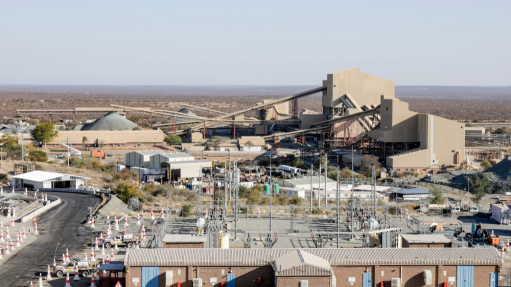
Photo by: De Beers Group
Name of the Project
Venetia Underground Project (VUP).
Location
Venetia mine, in Limpopo, South Africa.
Project Owner/s
Anglo American subsidiary De Beers Consolidated Mines.
Project Description
Venetia is currently the biggest diamond mine development under way anywhere in the world.
The mine is an openpit operation; however, following shareholder approval, development work started in late 2013 to build the new underground mining operation beneath the current operating openpit.
The VUP will extend the mine life to 2046 and yield 82-million carats from about 115-million tonnes of material.
The project comprises the K01 and K02 orebodies. Both kimberlites extend below surface, enabling De Beers to mine to depths of up to 1 000 m. There are indications that K01 extends below 1 000 m, and De Beers may explore options that extend the underground operation’s life beyond 2046.
K01 – a sizeable orebody measuring 550 m x 120 m – will be responsible for the majority of production, generating an average of 3.5-million carats from about 4.5-million tonnes a year of material.
The K02 orebody – measuring 200 m x 300 m – will provide the balance, producing about one-million carats from 1.5-million tonnes to 2.5-million tonnes a year of material.
The current mining solution for the underground project will use sublevel caving to extract material from both orebodies. Further optimisation studies are being completed to determine whether the K02 orebody should be mined using a block cave mining methodology.
Underground infrastructure comprises two vertical shaft systems for personnel transport, ore transport and the routing of services, as well as lateral access to levels on the 54L, 91L and 94L stations for the services shaft, and on the 100L station for the production shaft.
The service shaft has a completed internal diameter of 7 m and will eventually provide all the services and people transport for the underground workings, while the production shaft, also with a finished internal diameter of 7 m, will be fitted with two rock winders, each having two 24 t payload skips.
The service and production shafts will serve as downcast air intakes to the underground workings, while a decline and pit ramp will assist with early underground access for the construction of the production infrastructure for K01 and K02, which will be developed concurrently to the vertical shafts.
They will also serve as additional air intakes and logistical access points, which VUP says will mitigate the immediate requirement for the use of the shafts for ground handling.
Overall, VUP will undertake 61.5 km of initial excavations as part of the expansion project, as well as a further 177 km of excavations over the remainder of the underground life-of-mine.
Surface infrastructure, which includes change houses, a heat-tolerance testing centre, a lamp room, a proto room, a control room, winder houses, workshops, warehouses, ventilation systems and a state-of-the-art training facility, were completed in early 2021.
De Beers also plans to have Venetia operating as carbon neutral by 2030; using battery electric vehicles and installing a 60 MW solar photovoltaic plant are expected to help achieve that goal.
The ultimate sizing of the energy plant is yet to be finalised.
Potential Job Creation
The project currently employs 4 300 people, with the majority of employees living in the surrounding Musina and Blouberg communities. The VUP will not only continue to be a key employer in the area but is also focused on the transfer of key skills to local employees, which will ensure a sustainable world-class mechanised mining operation. This is enabled through the local training centre facilities that were completed in 2021.
Net Present Value/Internal Rate of Return
Not stated.
Capital Expenditure
De Beers’ $2.3-billion investment in the VUP represents the biggest single investment in South Africa’s diamond industry in decades.
Planned Start/End Date
Venetia ceased openpit operations in December 2022 after 30 years of openpit production. First production from VUP was achieved in June 2023. The project is expected to ramp up to full production from 2024 onwards. Nameplate capacity is expected to be reached in 2026.
Latest Developments
The overall underground construction project is 73% complete. Surface infrastructure is nearing completion, and the underground construction is tracking well in line with the preproduction and production ramp-up.
The operational readiness programme, which includes all aspects of people, systems, assets and process readiness for the underground operation is tracking favourably against the schedule.
The autonomous journey is also under way with several autonomous mining systems expected to undertake multiple mining processes by 2028. In January 2024, the project launched the Integrated Operations Centre, a digital facility that uses advanced technology to monitor potential hazards and create a safe underground environment.
Key Contracts, Suppliers and Consultants
Murray & Roberts Cementation (development of underground mine); Redpath Australia (development of the underground mine with the De Beers team, working as the integrated owners team); Sandvik (intelligent loaders and trucks); and Rajant (network nodes, or BreadCrumbs).
Other contractors involved include Worley, BMH, BBE, ABB, Grinaker and Louwill.
Contact Details for Project Information
De Beers Group Managed Operations senior communications manager Jackie Mapiloko, tel +27 11 374 7173 or email jackie.mapiloko@debeersgroup.com.